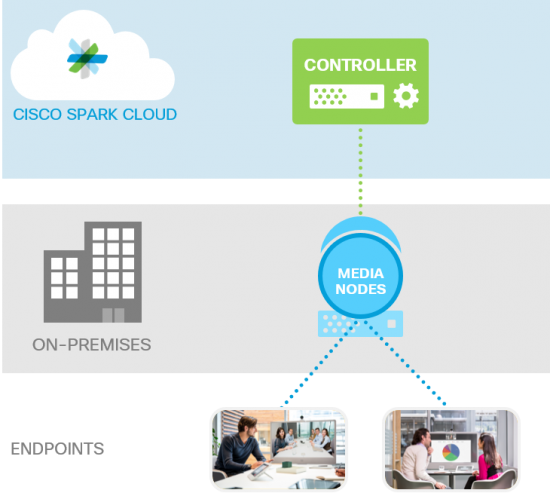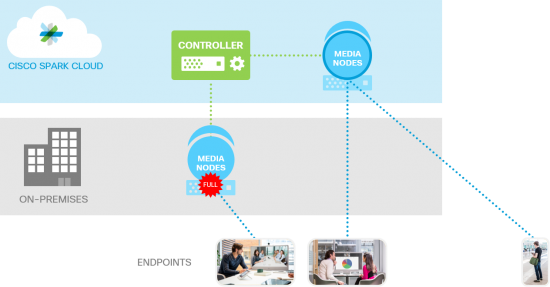Traditionally, the video conferencing market has been very firmly divided into premises-based products and cloud-based products. Premises-based products still dominate, though there is significant growth in cloud-based solutions. With premises products, IT departments deploy servers that they own and operate. Those servers provide the bridging, mixing, and switching functions for voice, video, and content share that make the meeting happen. With cloud-based solutions, a similar server exists – but – it’s in the cloud, of course, and it’s owned and operated by the SaaS vendor.
Premises-based solutions have many advantages. By far the most important one is quality. Video conferencing is often done using dedicated video conferencing endpoints – such as our MX, SX, DX, and Cisco Spark Room Kit series. These endpoints feature large screens and high-quality cameras. Users expect fantastic quality – high definition, low latency, high frame rate, and error-free video. Delivering that quality requires a great endpoint, but also a great network. By deploying the servers on premises, IT teams can tightly manage the available bandwidth and quality of service to deliver the experience their users expect.
However, on-premises video also comes with drawbacks. IT has to deploy and operate these servers. The servers must be regionally deployed. Enough capacity must be rolled out to handle peak load. And sometimes demand can be unexpectedly high, causing users to have no access during these peak times. Users in remote geographies may suffer because the video servers are deployed in campus locations far away. All these issues are handily solved by cloud-based solutions – like Cisco Spark and WebEx CMR meetings. Of course, once the cloud is involved, it means the public Internet — and that means all bets are off regarding quality. It also means bandwidth consumption to send all the video to the cloud and back.
Rethinking the Architecture of Video Conferencing
At Cisco, we realized that we needed to dramatically change things. We needed to literally rethink the very architecture of video conferencing. We needed to build a solution that brings the benefits of premises-based video – that amazing quality – while also bringing the benefits of cloud, without dramatically increasing bandwidth usage. We also needed to bring together the traditionally disparate technologies for video conferencing, web conferencing, and audio conferencing, so that users just join meetings and that’s it.

And rethink it we did. Last year, we launched the first phase of Cisco Spark Hybrid Media Service. This groundbreaking technology allows customers of Cisco Spark to deploy a server on premises – called a media node. This server would register itself to our cloud and make itself available as a conferencing resource. Users would join Cisco Spark meetings as they normally do, but if they happened to be on campus, they’d use the on-premises node.

If there was no available media node, or it was out of capacity, the meeting would use the closest node in our global data centers. This solution provides the quality and reliability of premises video, but the ease of management, infinite scale, and geographic reach of our cloud to fill the gaps of the on-premises media node deployment.
Our hybrid media solution worked for Cisco Spark space meetings. Users needed to join them from one of the Cisco Spark applications, or from one a Cisco Spark registered video endpoints. That was a great start, but we knew it was just the beginning. It had two big limitations that we then worked to address. The first was that it only worked for Cisco Spark meetings – not WebEx meetings. And second, it only worked from Cisco-made cloud-registered video endpoints. It didn’t work with any of the existing installed base of mostly SIP-based video systems that we, and our competitors, have been shipping for years and years. This made it a great start but limited its applicability.
Reinventing the Video Conferencing Market
I’m pleased to announce that we’ve overcome these limitations. Available today, our next generation of hybrid media service now works for WebEx CMR meetings (assuming customers are on the latest, greatest WebEx release). In addition, it allows any SIP-compliant video endpoint registered to our call control solutions (UC Manager or VCS) or even a competitor’s, to join those WebEx CMR or Spark meetings — and when they do, utilize the hybrid media node for the meeting.
This dramatically expands the scope of applicability for hybrid media and turns the solution from something kind of neat to something that can be deployed, at scale, as a complete video and web conferencing solution for an enterprise. All your existing SIP-based video endpoints can join these meetings, and it works with the meeting solution already deployed in most enterprises – WebEx.
We’ve torn down the silos between traditional premises and cloud products, and invented an entirely new category of meeting product.
With this new release of Cisco Spark Hybrid Media Services, the video conferencing market is truly reinvented. We’ve torn down the silos between traditional premises and cloud products, and invented an entirely new category of meeting product.
For existing WebEx customers, this solution means you can dramatically improve the quality of the meeting experience for users joining from video endpoints — and reduce bandwidth costs when they do. For existing video customers, it provides a great way to expand video usage using the scale of the Cisco cloud, and through Cisco Spark, provide a great way for users to join meetings anywhere.
Of course, Cisco partners benefit as well with a great reason to bring video and Cisco Spark to existing WebEx customers and bring WebEx and Cisco Spark to existing video customers, as well as a great incentive to expand usage across all of them.
And of course, we’re not done revolutionizing the meetings experience – there is a lot more magic yet to come.
Explore more about Cisco Spark Hybrid Media Services.

Agree that hybrid solutions are best for many of our customers for both reliability and flexibility purposes. The current challenge Operations teams face however; is the need for centralized management and reporting of the entire solution. Regardless of where the components reside, customers will need unified management tools for their bridging and UC solutions to track utilization, capacity, incidents, etc.
We've been running the Spark Hybrid Media Node for a little while now… very impressed with the enhanced reporting for both on-premises and cloud usage through the Spark Control Hub (admin portal). This announcement means we can consolidate a number of disparate MCU services. #happydays
Glad to hear your liking your experience with the product!
Thats a great observation – definitely true. And for hybrid media thats exactly how it works. The on-prem media component is really a cloud managed compute appliance. Its 100% provisioned, configured, upgraded through the cloud. In fact, software update is hitless, automated and doesnt even need to be done by the admin – it just happens. Best of all worlds.